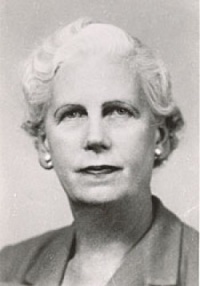Phoebe D. Bendit

THIS ARTICLE IS UNDER CONSTRUCTION
Phoebe Payne Bendit was a noted clairvoyant and, with her husband, the psychiatrist Laurence J. Bendit, a medical researcher. The Bendits were long-time members of the Theosophical Society. British by birth, they spent many years working at The Theosophical Society in America in Wheaton, Illinois, and also at the Krotona Institute in Ojai, California.
Phoebe Daphne Payne was born in either 1889 or 1891 [1] in London’s East End, where her father was employed by the Thames Iron Works. John Payne, of Southern Irish and French Huguenot heritage, evidently was a restless soul, and the small family moved around a great deal during Phoebe's childhood. Her mother was English and trained as a teacher, which was fortunate since young Phoebe attended a dozen schools in as many years.[2]
Phoebe was clairvoyant from birth. According to her husband, she described this as follows: "To be born clairvoyant is an odd thing, because one is quite unable to assess ordinary life without its counterpart of extra sensory perception. I do not remember a time when the visible world did not play into and through another world. I had no idea where one ended and the other began: they were both to me ordinary and natural, and they belonged together. . . . The world of the living and of ordinary affairs wove itself across the pattern of the so-called dead and their environment. It was therefore logical enough that, as a child, I should find it extremely difficult to understand what people meant by death, or why they were gloomy about the subject. . . But being accustomed to the presence of dead people is only a small part of the psychic's life, the threads of which naturally weave themselves through the commonplace happenings of everyday life."
Apparently she wasn't given to talking much — or at all — about her perceptions, because she was 19 years old before it became clear to her just how different she was from most people. One Sunday at the City Temple, a "famous non-conformist hall" in central London, she observed three woman who were energetically singing along with the rest of the congregation — and who were floating in the air between the chapel floor and the balcony. Amused by this at first, she next realized that no one else seemed to be able to see them.
This revelation scared her quite badly, and she spent several weeks worrying about whether she might be mentally unbalanced. Fortunately she then met a medium, an older woman named Mrs. Neil, who helped her understand her extraordinary gift. The two women became good friends and were housemates for several years, studying and learning together.
After Mrs. Neil died, Phoebe began working as a secretary at the Stead Bureau, established in 1909 by W.T. Stead with the intention of "attempting to bridge the abyss between the Two Worlds ... [of] the incarnate and discarnate halves of the human race." [3] Although she attended many séances and liked and trusted the mediums she knew, believing they were motivated by a wish to help others, she was never a spiritualist. For young Phoebe, attending a séance was an opportunity to observe and learn.
According to her husband, Phoebe also studied at the British College of Psychic Science in London, which had been founded in 1920 by J. Hewat and Barbara McKenzie to investigate and experiment with psychic phenomena. (Although Hewat McKenzie died in 1929, his wife and others kept the school going until the mid-1940s.[4]) Among others, the well-known medium Eileen Garrett (1893-1970) worked with the BCPS staff during Phoebe's time there.[5]
Phoebe did some experimenting of her own while at the BCPS, which got her into some trouble. She found that if she thought about something hard enough and concentrated on projecting her thought, the medium in the center of the circle would begin to talk about what she had projected. Phoebe told some of her colleagues that she was going to cause the medium to produce the dead fiancée of a bachelor who had never had a fiancée --- and this was exactly what happened at the next séance. Summoned to the director's office and told she must not do things like that, her response was, essentially, that being an active experimenter was preferable to being a passive listener. The faculty did not agree with her, and given the choice of either obeying or leaving, she left the school.[6]
Notes
- ↑ Most sources say 1891, but an article her husband wrote the year after her death (see next reference) says 1889.
- ↑ Information about Phoebe Payne's early life is from Psypioneer, Vol. 4, No. 10, Oct 2008: Reprint of a profile of Phoebe Payne Bendit by her husband, Laurence J. Bendit, which originally appeared in the Newsletter of the Parapsychology Foundation of New York, Vol. 16, No. 5, Sept-Oct 1969.
- ↑ See http://www.attackingthedevil.co.uk/reviews/bureau.php, which is apparently an article from the Fortnightly Review (1909) by Mr. Stead.
- ↑ See http://www.pflyceum.org/343.html and http://encyclopedia2.thefreedictionary.com/British+College+of+Psychic+Science.
- ↑ See the article by Dr. Bendit at http://www.woodlandway.org/PDF/PP4.10October08.pdf.
- ↑ Ibid.
